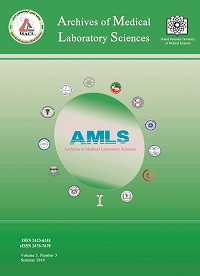A Comparative Study of 25 (OH) Vitamin D Serum Levels in Patients with metabolic syndrome and healthy individuals
Archives of Medical Laboratory Sciences,
Vol. 5 No. 3 (2019),
1 Tir 2019
,
Page 11-15
https://doi.org/10.22037/amls.v5i3.29869
Abstract
Background: The incidence of metabolic syndrome has been rising in the Iran population. In parallel, vitamin D deficiency has also been increasing in Iran. This study aims to explore the association of vitamin D serum concentrations with metabolic syndrome and its components in the Iranian population. Materials and Methods: A case-control study was managed. We enrolled 110 metabolic syndrome patients, according to the National Cholesterol Education Program Adult Treatment Panel III (ATP III) criteria as a case group and 130 healthy individuals as a control group. The serum level of 25-hydroxy vitamin D (25 (OH)D), lipid profile, and fasting blood glucose(FBS) status were determined using a commercially available ELISA method. Enzymatic methods determined total cholesterol (Chol), high-density lipoprotein (HDL) cholesterol, low-density lipoprotein (LDL), and triglyceride (TG) levels. Results: In case group, the prevalence rate of 25 (OH)D deficiency (<10 ng/mL) was 10%, 25 (OH)D insufficiency (10–29 ng/mL) was 71.0%, and 25 (OH)D sufficiency (>30 ng/mL) was 19.0%. A non-significant association between Chol level and age was noted (p=0.46, p=0.124). The levels of FBS and TG were significantly higher, and the levels of 25 (OH)D, LDL, and HDL were significantly lower in the case of the group compared to the control group. Conclusion: We found that the serum level of 25 (OH)D in patients with metabolic syndrome is lower than in the healthy group, and a low level of 25 (OH)D is related to increased risk of metabolic syndrome and its components.
- Metabolic syndrome
- 25 (OH)D
- Triglyceride
- High-density lipoprotein
- Low-density lipoprotein.
How to Cite
References
Grundy SM. Metabolic syndrome update. Trends in cardiovascular medicine. 2016;26(4):364-73.
Després J-P, Lemieux I. Abdominal obesity and metabolic syndrome. Nature. 2006;444(7121):881-7.
Ghobadi S, Rostami ZH, Marzijarani MS, Faghih S. Association of vitamin D status and metabolic syndrome components in Iranian children. International journal of preventive medicine. 2019;10.
Wimalawansa SJ. Associations of vitamin D with insulin resistance, obesity, type 2 diabetes, and metabolic syndrome. The Journal of steroid biochemistry and molecular biology. 2018;175:177-89.
Tabrizi R, Moosazadeh M, Akbari M, Dabbaghmanesh MH, Mohamadkhani M, Asemi Z, et al. High prevalence of vitamin d deficiency among iranian population: A systematic review and meta-analysis. Iranian journal of medical sciences. 2018;43(2):125.
Abazari O, Divsalar A, Ghobadi R. Inhibitory effects of oxali-Platin as a chemotherapeutic drug on the function and structure of bovine liver catalase. J Biomol Struct Dyn. 2020;38(2):609-15.
Autier P, Boniol M, Pizot C, Mullie P. Vitamin D status and ill health: a systematic review. The lancet Diabetes & endocrinology. 2014;2(1):76-89.
Christakos S, Dhawan P, Verstuyf A, Verlinden L, Carmeliet G. Vitamin D: metabolism, molecular mechanism of action, and pleiotropic effects. Physiological reviews. 2016;96(1):365-408.
Scragg R, Stewart AW, Waayer D, Lawes CM, Toop L, Sluyter J, et al. Effect of monthly high-dose vitamin D supplementation on cardiovascular disease in the vitamin D assessment study: a randomized clinical trial. JAMA cardiology. 2017;2(6):608-16.
Pittas AG, Dawson‑Hughes B, Sheehan P, Ware JH, Knowler WC, Aroda VR, et al. Vitamin D supplementation and prevention of type 2 diabetes. 2019.
Abazari O, Shafaei Z, Divsalar A, Eslami-Moghadam M, Ghalandari B, Saboury AA. Probing the biological evaluations of a new designed Pt (II) complex using spectroscopic and theoretical approaches: Human hemoglobin as a target. J Biomol Struct Dyn. 2016;34(5):1123-31.
Sulistiowati E, Sihombing M. NCEP-ATP III and IDF criteria for metabolic syndrome predict type 2 diabetes mellitus. Universa Medicina. 2016;35(1):46-55.
Kaur J. A comprehensive review on metabolic syndrome. Cardiology research and practice. 2014;2014.
Aguilar M, Bhuket T, Torres S, Liu B, Wong RJ. Prevalence of the metabolic syndrome in the United States, 2003-2012. Jama. 2015;313(19):1973-4.
Abazari O, Shafaei Z, Divsalar A, Eslami-Moghadam M, Ghalandari B, Saboury AA, et al. Interaction of the synthesized anticancer compound of the methyl-glycine 1, 10-phenanthroline platinum nitrate with human serum albumin and human hemoglobin proteins by spectroscopy methods and molecular docking. Journal of the Iranian Chemical Society. 2020:1-14.
Bahar A, Kashi Z, Kheradmand M, Hedayatizadeh-Omran A, Moradinazar M, Ramezani F, et al. Prevalence of metabolic syndrome using international diabetes federation, National Cholesterol Education Panel-Adult Treatment Panel III and Iranian criteria: results of Tabari cohort study. Journal of Diabetes & Metabolic Disorders. 2020:1-7.
Strange RC, Shipman KE, Ramachandran S. Metabolic syndrome: A review of the role of vitamin D in mediating susceptibility and outcome. World journal of diabetes. 2015;6(7):896.
Godala M, Materek-Kuśmierkiewicz I, Moczulski D, Rutkowski M, Szatko F, Gaszyńska E, et al. The risk of plasma vitamin A, C, E and D deficiency in patients with metabolic syndrome: a case-control study. Advances in Clinical and Experimental Medicine. 2017;26(4):581-6.
Parker J, Hashmi O, Dutton D, Mavrodaris A, Stranges S, Kandala N-B, et al. Levels of vitamin D and cardiometabolic disorders: systematic review and meta-analysis. Maturitas. 2010;65(3):225-36.
Gagnon C, Lu ZX, Magliano DJ, Dunstan DW, Shaw JE, Zimmet PZ, et al. Low serum 25-hydroxyvitamin D is associated with increased risk of the development of the metabolic syndrome at five years: results from a national, population-based prospective study (The Australian Diabetes, Obesity and Lifestyle Study: AusDiab). J Clin Endocrinol Metab. 2012;97(6):1953-61.
Abbasi M, Abazari OO. Probing the Biological evaluations of a new designed Palladium (II) complex using spectroscopic and theoretical approaches: Human Hemoglobin as a Target. Arch Med Lab Sci. 2018;3(3).
Saedisomeolia A, Taheri E, Djalali M, Moghadam AM, Qorbani M. Association between serum level of vitamin D and lipid profiles in type 2 diabetic patients in Iran. Journal of Diabetes & Metabolic Disorders. 2014;13(1):7.
Talaei A, Mohamadi M, Adgi Z. The effect of vitamin D on insulin resistance in patients with type 2 diabetes. Diabetology & metabolic syndrome. 2013;5(1):8.
Vatandost S, Jahani M, Afshari A, Amiri MR, Heidarimoghadam R, Mohammadi Y. Prevalence of vitamin D deficiency in Iran: a systematic review and meta-analysis. Nutrition and health. 2018;24(4):269-78.
- Abstract Viewed: 245 times
- pdf Downloaded: 111 times
